by Eric Meier
When attempting to identify a wood sample, it’s important to keep in mind the limitations and obstacles that are present in our task. Before starting, please have a look at The Truth Behind Wood Identification to approach the task in a proper mindset; I consider the linked article to be required reading for all those visiting my site with the intent of identifying wood.
1. Confirm it is actually solid wood.
Before proceeding too much farther into the remaining steps, it’s first necessary to confirm that the material in question is actually a solid piece of wood, and not a man-made composite or piece of plastic made to imitate wood.
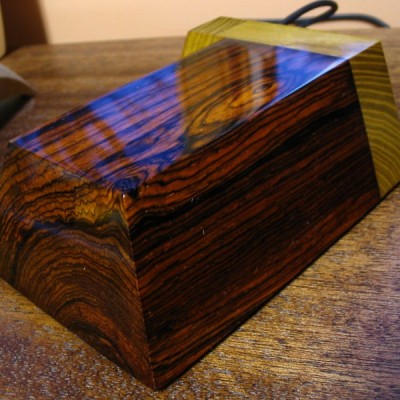
Can you see the end-grain?
Manufactured wood such as MDF, OSB, and particleboard all have a distinct look that is—in nearly all cases—easily distinguishable from the endgrain of real wood. Look for growth rings—formed by the yearly growth of a tree—which will be a dead-giveaway that the wood sample in question is a solid, genuine chunk of wood taken from a tree.
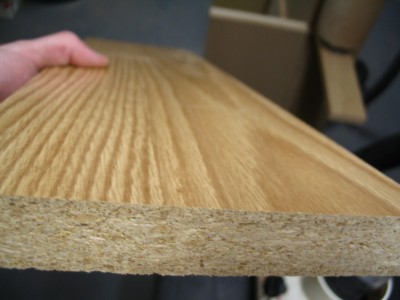
Is it veneered?
If you see a large panel that has a repeating grain pattern, it may be a veneer. In such cases, a very thin layer of real wood is peeled from a tree and attached to a substrate; sometimes the veneer can be one continuous repeating piece because it is rotary-sliced to shave off the veneer layer as the tree trunk is spun by machines. Assuming it is a real wood veneer with a distinct grain and texture—and not merely a piece of printed plastic—you may still be able to identify the outer veneer wood in question, but you should still realize that is it only a veneer and not a solid piece of wood.
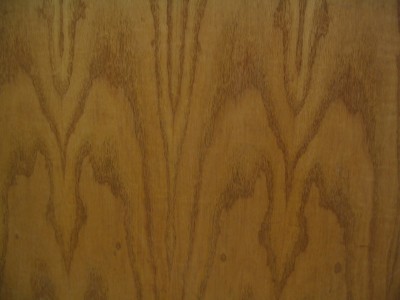
Is it painted or printed to look like wood?
Many times, especially on medium to large-sized flat panels for furniture, a piece of particleboard or MDF is either laminated with a piece of wood-colored plastic, or simply painted to look like wood grain. Many of today’s interior hardwood flooring planks are good examples of these pseudo-wood products: they are essentially a man-made material made of sawdust, glues, resins, and durable plastics.
2. Look at the color.
Some questions to immediately ask yourself:
Is the color of the wood natural, or is it stained?
If there is even a chance that the color isn’t natural, the odds are increased that the entire effort of identifying the wood will be in vain.
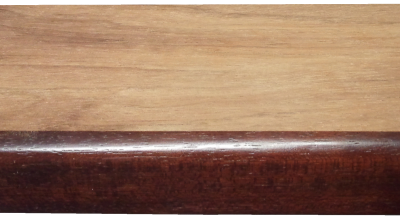
Is it weathered or have a patina?
Many woods, when left outside in the elements, tend to turn a bland gray color. Also, even interior wood also takes on a patina as it ages: some woods get darker, or redder, and some even get lighter or lose their color; but for the most part, wood tends to darken with age.
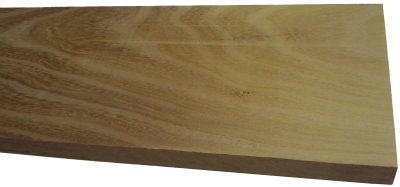
Is it possible to sand or plane the board to see the natural raw color of the wood?
The most predictable baseline to use when identifying wood is in a freshly sanded state. This eliminates the chances of a stain or natural aging skewing the color diagnosis of the wood.
3. Observe the wood grain.
If the wood is unfinished, then look at the texture of the grain. Ask yourself these questions:
Does the wood have an open, porous texture?
Most softwoods will be almost perfectly smooth with no grain indentations, while many common hardwoods have an open pore structure, such as oak or mahogany; though there are some hardwoods that are also smooth to the touch, such as maple.
Can you tell if the wood is quartersawn or plainsawn?
By observing the grain patterns, many times you can tell how the board was cut from the tree. Some wood species have dramatically different grain patterns from plainsawn to quartersawn surfaces. For instance, on their quartersawn surfaces, lacewood has large lace patterns, oak has flecks, and maple has the characteristic “butcher block” appearance.
Is there any figure or unusual characteristics, such as sapwood, curly or wild grain, burl/knots, etc.?
Some species of wood have figure that is much more common than in other species: for example, curly figure is fairly common in soft maple, and the curls are usually well-pronounced and close together. Yet when birch or cherry has a curly grain, it is more often much less pronounced, and the curls are spaced farther apart.
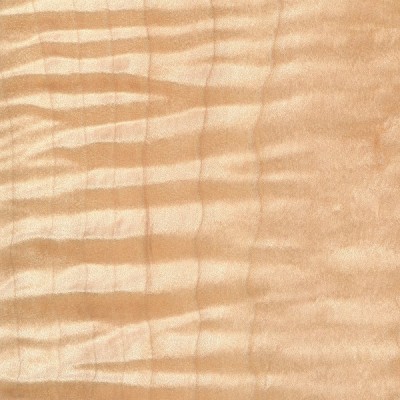
4. Consider the weight and hardness of the wood.
If it’s possible, pick the piece of wood up and get a sense of its weight, and compare it to other known wood species. Try gouging the edge with your fingernail to get a sense of its hardness. If you have a scale, you can take measurements of the length, width, and thickness of the wood, and combine them to find the density of the wood. This can be helpful to compare to other density readings found in the database. When examining the wood in question, compare it to other known wood species, and ask yourself these questions:
Is the wood dry?
Wood from freshly felled trees, or wood that has been stored in an extremely humid environment will have very high moisture contents. In some freshly sawn pieces, moisture could account for over half of the wood’s total weight! Likewise, wood that has been stored in extremely dry conditions of less than 25% relative humidity will most likely feel lighter than average.
How does the wood’s weight compare to other species?
Taking into account the size of the board, how does its weight compare to other benchmark woods? Is it heavier than oak? Is it lighter than pine? Look at the weight numbers for a few wood species that are close to yours, and get a ballpark estimate of its weight.
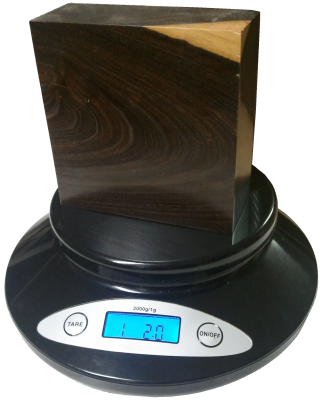
How hard is the wood?
Obviously softwoods will tend to be softer than hardwoods, but try to get a sense of how it compares to other known woods. Density and hardness are closely related, so if the wood is heavy, it will most likely be hard too. If the wood is a part of a finished item that you can’t adequately weigh, you might be able to test the hardness by gouging it in an inconspicuous area. Also, if it is used in a piece of furniture, such as a tabletop, a general idea of its hardness can be assessed by the number and depth of the gouges/dings in the piece given its age and use. A tabletop made of pine will have much deeper dents than a tabletop made of Oak. Additionally, you can always try the “fingernail test” as a rough hardness indicator: find a crisp edge of the wood, and with your fingernail try to push in as hard as you can and see if you’re able to make a dent in the wood.
5. Consider its history.
Many times we forget common sense and logic when attempting to identify wood. If you’ve got a piece of Amish furniture from Pennsylvania, chances are more likely that the wood will be made of something like black walnut or cherry, and not African wenge or jatoba. You might call it “wood profiling,” but sometimes it can pay to be a little prejudiced when it comes to wood identification. Some common-sense questions to ask yourself when trying to identify a piece of wood:
Where did it come from?
Knowing as much as you can about the source of the wood—even the smallest details—can be helpful. If the wood came from a wood pile or a lumber mill where all the pieces were from trees processed locally, then the potential species are immediately limited. If the wood came from a builder of antique furniture, or a boat-builder, or a trim carpenter: each of these occupations will tend to use certain species of woods much more often than others, making a logical guess much simpler.
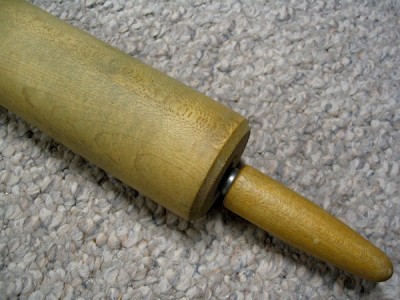
How old is it?
As with the wood’s source, its age will also help in identification purposes. Not only will it help to determine if the wood should have developed a natural patina, but it will also suggest certain species which were more prevalent at different times in history. For instance, many acoustic guitars made before the 1990s have featured Brazilian rosewood backs/sides, yet due to CITES restrictions placed upon that species, East Indian rosewood became a much more common species on newer guitars. (And this is a continuing shift as newer replacements are sought for rosewoods altogether.)
How large is the piece of wood?
Some species of trees are typically very small—some are even considered shrubs—while others get quite large. For instance, if you see a large panel or section of wood that’s entirely black, chances are it’s either painted, dyed, or stained: Gaboon ebony and related species are typically very small and very expensive.
What is the wood’s intended use?
Simply knowing what the wood was intended for—when considered in conjunction with where it came from and how old it is—can give you many clues to help identify it. In some applications, certain wood species are used much more frequently than others, so that you can make an educated guess as to the species of the wood based upon the application where it was used. For instance, in the United States: many older houses with solid hardwood floors have commonly used either red oak or hard maple; many antique furniture pieces have featured quartersawn white oak; many violins have spruce tops; many closet items used aromatic red cedar, and so forth. While it’s not a 100% guarantee, “profiling” the wood in question will help reduce the number of possible suspects, and aid in deducing the correct species.
6. Find the X-Factor.
Sometimes, after all the normal characteristics of a sample have been considered, the identity of the wood in question is still not apparent. In these instances—particularly in situations where a sample has been narrowed down to only a few possible remaining choices—it’s sometimes helpful to bring in specialized tests and other narrower means of identification.
The following techniques and recommendations don’t necessarily have a wide application in initially sorting out wood species and eliminating large swaths of wood species, but will most likely be of use only as a final step in special identification circumstances.
Odor
Believe it or not, freshly machined wood can have a very identifiable scent. When your eyes and hands can’t quite get a definitive answer, sometimes your nose can. Assuming there is no stain, finish, or preservative on or in the wood, quickly sand, saw, or otherwise machine a section of the wood in question, and take a whiff of the aroma.
Although new scents can be very difficult to express in words, many times the scent of an unknown wood may be similar to other known scents. For instance, rosewoods (Dalbergia spp.) are so named for their characteristic odor that is reminiscent of roses. Although difficult to directly communicate, with enough firsthand experience scents can become a memorable and powerful means of wood identification.
Fluorescence
While certain woods can appear basically identical to one another under normal lighting conditions, when exposed to certain wavelengths—such as those found in blacklights—the wood will absorb and emit light in a different (visible) wavelength. This phenomenon is known as fluorescence, and certain woods can be distinguished by the presence or absence of their fluorescent qualities. See the article Fluorescence: A Secret Weapon in Wood Identification for more information.
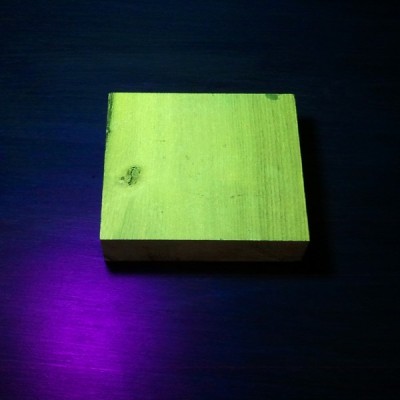
Chemical Testing
There are only a small number of chemical tests regularly used on wood, most of which are very specialized and were developed to help distinguish easily confused species with one another. They work by detecting differences in the composition of heartwood extractives. A chemical substance (called a reagent) is usually dissolved in water and applied to the wood surface: the surface is then observed for any type of chemical reaction (and accompanying color change) that may occur. Two of the most useful are the tests that are meant to separate Red and White Oak, and Red and Hard Maple.
Heartwood Extractives Leachability
Sometimes a wood species will have heartwood extractives that will be readily leachable in water and capable of conspicuously tinting a solution of water a specific color. For instance, the heartwood extractives contained in osage orange (Maclura pomifera) contain a yellowish-brown dye that is soluble in water. (This can sometimes be observed anecdotally when the wood is glued with a water-based adhesive: the glue’s squeeze-out is an unusually vibrant yellow.)
In a simple water extract color test, wood shavings are mixed with water in a vial, test tube, or other suitably small container, and the color of the water is observed after a few minutes. If the heartwood extractives are leachable by water, then a corresponding color change should quickly occur.
In addition to osage orange (Maclura pomifera), merbau (Intsia spp.), and rengas (Gluta spp. and Melanorrhoea spp.) are also noted for their readily leachable heartwood extractives. Because this property is quite uncommon, it can serve to quickly differentiate these woods from other lookalikes.
7. Look at the endgrain.
Perhaps no other technique for accurate identification of wood is as helpful and conclusive as the magnified examination of the endgrain. Frequently, it brings the identification process from a mostly intuitive, unscientific process into a predictable, repeatable, and reliable procedure.
Looking at the endgrain with a magnifier shouldn’t be a mystifying or esoteric art. In many cases, it’s nearly as simple as examining small newsprint under a magnifying glass. There are three components necessary to reap the full benefits contained in the endgrain:
I. A prepared surface.
When working with wood in most capacities, it becomes quickly apparent that endgrain surfaces are not nearly as cooperative or as easily worked as face grain surfaces. However, in this case, it is absolutely critical that a clear and refined endgrain surface is obtained.
For a quick glance of a softwood sample, a very sharp knife or razor blade can be used to take a fresh slice from the endgrain. However, in many denser species, especially in tropical hardwoods, one of the best ways to obtain a clear endgrain view is through diligent sanding. It’s usually best to begin with a relatively smooth saw cut (as from a fine-toothed miter saw blade) and proceed through the grits, starting at around 100, and working up to at least 220 or 320 grit, preferably higher for the cleanest view.
II. The right magnifier.
It need not be expensive, but whatever tool is used to view the endgrain should have adequate magnifying power. In most instances, 10x magnification is ideal, however, anything within the range of 8 to 15x magnification should be suitable for endgrain viewing. (Standard magnifying glasses are typically in the range of 2 to 4x magnification.)
These stronger magnifiers, sometimes called loupes, usually have a smaller viewing area than standard magnifying glasses. Fancier models—with built in lights, or larger viewing surfaces—are available at a premium; but the most basic models are usually only a few dollars.
III. A trained eye.
The third element that constitutes a proper endgrain examination is simply knowing what to look for. In analyzing the patterns, colors, shapes, and spacing of the various anatomical features, there is a veritable storehouse of information within the endgrain—all waiting to be unlocked. Yet, if these elements have not been pointed out and learned, the array of features will simply seem like an unintelligible jumble. The discipline of recognizing anatomical endgrain features is not easily summed up in a few sentences or even a few paragraphs, but it is nonetheless critical to the identification process. To this end, an in-depth look should be given to the various categories, divisions, and elements that constitute endgrain wood identification on the macroscopic level. (In this regard, macroscopic denotes what can be seen with a low-powered, 10x hand lens—without the aid of a microscope—rather than simply what can be seen with the naked eye.) Because the anatomy between softwoods and hardwoods is so divergent, each will be considered and examined separately:Still stumped?
If you have a mysterious piece of wood that you’d like identified, you’ve got a few options for next steps:USDA’s Forest Products Laboratory
You can mail your physical wood samples to the Center for Wood Anatomy Research.
Pros:
- Free
- Professional wood identification
Cons:
- Only available to US citizens
- Slow turnaround times (up to a month or more)
- Limited to three IDs per year
See their Wood ID Factsheet for more info.
Alden Identification Service
You can mail your physical wood samples (even small sections taken from antiques) to Alden Identification Service.
Pros:
- Professional wood identification
- Faster turnaround times (ranging from a few days to a week or two)
Cons:
- Paid service
See their ordering page for more info. (Note that Harry Alden has written several books while at USDA, including both Hardwoods and Softwoods of North America.)
Ask for help online
If the wood ID is merely a curiosity, or non-critical, you can post pictures of the wood in question.
Pros:
- Free
- No need to send physical samples
Cons:
- Greatly limited by the quality of the pictures provided
- Extra work usually required to get adequate clarity in photos
See article of Common US Hardwoods to help find the most commonly used woods.
Get the hard copy
 If you’re interested in getting all that makes The Wood Database unique distilled into a single, real-world resource, there’s the book that’s based on the website—the Amazon.com best-seller, WOOD! Identifying and Using Hundreds of Woods Worldwide. It contains many of the most popular articles found on this website, as well as hundreds of wood profiles—laid out with the same clarity and convenience of the website—packaged in a shop-friendly hardcover book.
If you’re interested in getting all that makes The Wood Database unique distilled into a single, real-world resource, there’s the book that’s based on the website—the Amazon.com best-seller, WOOD! Identifying and Using Hundreds of Woods Worldwide. It contains many of the most popular articles found on this website, as well as hundreds of wood profiles—laid out with the same clarity and convenience of the website—packaged in a shop-friendly hardcover book. 





Why I will no longer be replying to every wood ID request I’ve replied to literally thousands of wood ID requests on this site over the past 13+ years, but as the site’s popularity has grown, so has the time demands for ID on a daily basis. (Contrary to what some may seem to think, I am not some all-knowing wood wizard that can instantly ID your wood. It can actually take me a long time to sift through a lot of different resources.) Over the past few years, my backlog of pending wood species to be added to the… Read more »
I got these samples from some pallets at work. I believe this is all the same species. It is some kind of very hardwood with beautiful grain patterns. Anyone know what it is?
Hmm, very interesting stuff. Definitely a diffuse porous tropical species of some sort. With pallet wood, it may be something completely obscure. A couple known woods that look very similar would be iroko and lati.
I looked around alot on the web after I sent the question to you and I had settled on lati. I believe that’s what it is but I’m still not 100% certain. Either way, this is some very pretty wood. I did part of a wall in my bedroom with it. Turned out well. A little Danish oil to really bring out the grain patterns
I bought this piece at an architectural salvage place in St. Louis. So it’s probably of Midwest origin. Came out of a barn. 12″x6/4×17′. Ran it through the planer and this is the result. Help!
It’s an old-growth softwood of some sort. Probably Douglas fir or possibly pine. Old growth timber like this tends to be heavier and stronger than the newer plantation grown stuff seen today.
That was my first thought given that it was pulled from a barn and most likely a floor joist or roof truss being 17′ long. The grain isn’t like anything I’ve seen before. Parts look like the grain you see in pine and some places look like maple to me, but it’s too soft for maple. On a side note, not sure how it’s related, If it’s a character of the wood or a product of whatever was done in the barn. Carrying it, I rubbed my bare arm against the unplaned board and the wood fibers imbedded in my… Read more »
Any chance of identifying our dining room table please?
I believe we were told this was from Bali. It was all hand made. It’s very, very, very heavy lol. I would guess it sinks. Thank you!
Please help to identify this table – it was handmade very expensive they made it in walnut or mahogany – trying to find out which one i have thanks
The wood in the pic looks like mahogany.
Thank you Eric
This is a vintage waffle cone roller. It is either Northern European or American. If American, I believe it to be maple. If European, perhaps it is beech? It is of medium weight—heavier than pine, but lighter than oak—and hardness. Any help is appreciated!
please attach pics
Photos attached.
To me, the grain and ray fleck looks closest to maple. It doesn’t appear to be beech.
Thank you!
2 weeks of sanding and I’m very curious about the wood type. I’d be remiss to think I know. Thanks in advance for any help.
Hi, I have sanded back this tallboy and would love to know what type of wood it is, it’s lovely! Can you help? Thank you!
Looks like a species of hard pine.
Eric, picked up this solid wood table. Trying to ID the wood type. Table was made by Hastings Table Co in Hastings MI and sold by a furniture company in Buffalo NY that closed in the 1950s. Thx for the help.
Looks like oak, probably white oak.
Hello! My hardwood floors… trying to find a match after some had to be torn up for a water leak. We were told they are Miami Dade pine, but have no real idea if that is correct. House built in the Florida Keys in 1984.
Oven hood I am told is solid wood.
Local hardwood store said it could be cherry like you said, but that it is probably alder. What do you think from these pictures? Thank you.
Alder is another (lower cost) possibility. I think you would be able to get a better look at it in person than I would through your pictures. Alder would have sporadic little dark vertical lines that almost look like slits on the face grain, while cherry would not. If you look closely at the face grain images of alder, you should see the darker colored little slits. There are perhaps 8-12 of them in the main picture of the wood on this page: https://www.wood-database.com/red-alder/
Vintage door that was stained a dark brown (see at the bottom), now sanded raw. Range of hues from almost blond to green to brown. (Don’t mind the casing)
I can’t see any green hue in the pics, but if it is, that would make yellow poplar a possibility. Superficially it also resembles black cherry, though I’d need to see the endgrain to tell more.
It’s possible that it is made from two or more wood species.
Eric,
This is an oven hood. I could check inside the hood and on the sides, and maybe disassemble a piece of it to see if its composite, veneer, or solid wood.
What do you think it is based on the visible grain pattern? Thank you
It looks like black cherry.
Old style tv stand – similar to a dresser in size
My best guess is that it is just stained birch plywood, colored in such a way to mimic cherry.
Quarter-sawn floorboard made of what?

It’s a softwood species, most likely antique heart pine. Douglas fir is another possibility. I can’t see enough details in the photo to check the size/frequency of resin canals.
Hi Eric,
Can you please tell me what type of wood this is?
Thank you.
Looks like walnut to me.
Is this pecky cypress?
If it’s not cypress, what do you think it is?
I’m sure sure it’s not cypress, but still dont know what it is. Here is a shot of the left drawer.
Can you re-attach pics? They didn’t come through. I would need to see closer shots of the grain and preferably the end grain as well.
Hickory, maybe?
End grain
I can’t see enough detail in the endgrain to ID anything. Perhaps the fact that I can’t see anything suggests that the wood has smaller pores arrange in a diffuse pattern that doesn’t stand out much, in which case it would suggest something like maple, and away from ring porous woods like hickory.
Thank you for your time.
What is this?
Hi – Would you be able to tell me what the trim is here? This is in my living room. It’s a 1920 bungalow in the NE that I bought a few months ago. I haven’t begun to do anything with the trim yet, but thankfully most of the rooms are unpainted! Thanks!
Looks like an old-growth dense softwood, probably heart pine, or possibly Douglas fir.
oh, I found Douglas fir in the kitchen under 70’s sheet vinyl so maybe that does make sense. It just didn’t look quite the same as that so I wasn’t sure. A lot of the floors were redone at some point with oak, but it’s obvious the trim was already there (not the best job in some areas). Thank you!
I bought these salad servers in Costa Rica about 10 years ago and have always wondered what kind of wood it is. It’s very dense and heavy. Don’t know if this is the natural color or if it’s stained. It doesn’t *look* stained to me, but I’m no expert. I wish I had a better picture but they were a gift for my dad, so not in my possession any more. I’d love to find a set for myself but don’t know what to search for!
It looks like black palm to me.
Thank you so much!
can someone help me identify the wood on my table. It was sold as cherry wood but I’m not so sure that’s correct. thank you.
Definitely looks like cherry to me.
Hi Eric, how about this wood? It’s on the walls in a house we just bought. Don’t have access to it yet. Probably there since 1961. This is in Northern California
Hard to say for sure, but definitely a softwood species. Possibly some sort of cedar?
Thanks for the quick look. It’s very possible/likely it’s cedar given the area and age. In a woodworkers group, the vote was pretty split between cedar and pecky cypress. Obviously, I’ve love it to be the cypress given the value of that wood. How do I find out for sure? More/different photos after we move in and I take it all down? I can then cut and sand a board to see what it’s natural look is. There is about 500bf of this in the house.
One quick indicator would be odor when being worked/sawed. If you are familiar with the odor of each wood in question, it can be an easy way to distinguish them.
roger that. I’ll be taking it down in 3-4 weeks, will post back then when I know.
It may be heavier than “fairly heavy”, but it’s a pretty large piece so it’s hard for me to define the weight. I’m hoping this is a softball for you.
Thanks for any help!
Given the very wide sapwood, I’m inclined to say it’s possibly black cherry. But if it’s as heavy as you say it is (many people overestimate the weight) it could be hickory. The two have very different pore patterns on the endgrain, but I can’t make out enough endgrain detail to answer conclusively.
Hi Eric I am so pleased I found this site. I have a rental property that I am restoring the floors in. They were stained and we have spent two days sanding them. It is a HUGE undertaking. I think they floors are pine or perhaps fir. I think they were done by the previous owner at least 20 years ago. They were stained, we are a good way along at removing the stain.
Yes, you’re correct in your ID. The wood is a softwood species. I can’t tell from the pictures much more than that. Sometimes wood odor can be another clue, but it can be hard to describe if you don’t have first hand experience with the different woods in question.
I have a solid ,strange wooden skull shaped hinged box Very knotty Heavy strange grain. Possibly a knot from a larger tree. Please tell the species of it.
I am refinishing a table and have stripped down to bare wood. I’m trying to determine the type of wood this is as I have never seen a grain like this. The leaf of the table is very heavy. Any insight would be appreciated. 2 pics attached.
It looks like rubberwood. Its very common in mass-produced imported furniture.
Hi Eric! I was wondering if you could help me figure out what type of wood this is
It looks like stained plywood, possibly just birch or pine.
Hello, I have an old armchair I’m restoring, built in Wisconsin, it had a dark stain and some sort of varnish finish. I stripped the finish off of the arms and found an interesting piece of reddish spotted wood on one of them. I’m wondering what it is and if the two arms are the same wood or just cut from different sections. Thanks!
Hi Eric, any thoughts on this wood?
Very hard to tell from the pics. It looks like a diffuse porous hardwood. My best guess would be some type of mahogany.
Hi! This article is incredibly informative. I am so glad I found it! I was wondering if you could help me identify the wood that this bench is made out of. It dates back to at least as early as the 1970s, but I’m not sure of its origin before that, if any. It is a bench that we plan on restoring, and is heavy like oak. I really appreciate your time! Thank you!
It’s a softwood, it looks closest to pine to me.
That was my guess. Thank you so very much!
This tree was cut down in our park just a few days ago. It has a distinct yellow color.
Looks like honey locust for sure.
Hello! Would you be able to identify the type of wood my floors are made of? Below are some pics. Thanks for any help you can offer!
Very hard to say, the floors look like they could use some TLC. Its possible they could be some very weathered maple or birch floors.
Thank you! They definitely need some TLC! Lol. I don’t think they’ve ever been refinished. I’m looking into whether to refinish or just replace. Anyway, thanks again!
These are my floors. Any idea on the type of wood?
Your floors are oak.
Hey Eric great post here, but I’m still trying to figure out what wood this is though I don’t have a magnifying glass to zoom into the grains, appreciate any input here.
Looks like a softwood, I think I can make out some resin canals, so if I’m seeing correctly, that would suggest a big slab of pine as the most likely candidate.
So happy I found your site! What type of wood is this? Kitchen Cabinets from a house in France. Thank you!
Another couple of images.
Superficially the color and grain resemble black cherry here in the US. But if it’s from France, it could well be something like pear instead. Both are fruitwoods with a similar appearance.
Love the blog and saw you’re answering questions right now! Any chance identifying the wood of this hand railing? It’s the original railing from a ~100 year old home that we are currently paint stripping. The original floors were pine, would that give you any hint?
Looks like oak.
Thanks Eric!
what type of wood? this is a 1949 bendix 95B3 radio Console that is freshly sanded! Some of the trims seems to have a greenish discoloration. Wood is very soft.
Looks like it’s made from different species. Hard to say for sure, but the solid trim that’s soft and with a greenish color is probably yellow poplar.
What type of wood?
Looks to be a veneered top. Hard to tell from the picture, but my guess from the limited view would be mahogany.
We love this midcentury wood paneling from our 1953 rancher, we would love to know what type of wood it is, if I had to guess I was thinking it was European Walnut in Crown Cut but I am not sure! Looking to an expert.
To me it looks like rotary cut veneer, possibly cherry or maybe birch with some darker heartwood included.
Please help me identify type of wood. Thank you
Wood is too weathered to make out enough details as is. Maybe sand away or saw into some fresh wood and we can see more details.
Thank you for your response. I’m on the way out to pressure wash and saw the end off one of the beams to help you help me. Will post pics shortly. Thanks again
Here are some better pics for you and anyone else that could help me identify type of wood. Sorry pics yesterday were shorty…..they’ve been dry stored for over fifty years though. Thank you very much
That looks like some very nice southern yellow pine. Sometimes called heart pine or even antique heart pine. The older stuff really is quite a bit stronger and heavier than the newer plantation grown stuff today.
Anyone know what this is? It’s an old vanity and bench
I received a box of wood yesterday and this piece has me stumped. It is very gorgeous and I would love to know so I can definitely find more.
I am looking at all kinds of wood doors, can you please tell me what kind of wood they are?
Hi Eric.
Thanks for providing a great civic service. I am wondering if you can tell me what wood my stairs are? Thank you very much.
Its a softwood of some sort, so something like pine, spruce, fir, etc.
Thank you very much.
Hi,
I have some large scale, likely industrial door handles, solid wood with brass tips and brackets.They’re super heavy. If you run you nail across the wood, you can feel the grain as its slightly indented.
Any ideas as to what wood it is?
Pic attached, they need a good clean!
Possibly teak
I have a shipping crate i need to figure out what kind of wood it is.
That’s a softwood, possibly pine or spruce.
Trying to find out what type of wood my great grandmas highboy is
The front panels could possibly be bookmatched veneer sheets of black walnut. It’s also possible that the rest of the piece is made from the same wood species as well.
I am curious as the what type of wood this is. I am wanting to get matching dressers however I dont know what type of wood this is. I inherited from a family member that recently past.
The wood is stained so it’s not it’s natural wood color. I can’t identify the wood species from the pic, but if you’re just looking to match the look, you could go with a reddish mahogany stain over a very plain wood like birch or poplar.
Here are more pics. I tried to get some without so much glare.
I do see some ray fleck on the upper surface in that first picture. There are a number of woods that it could be, and cherry is one of them since it can have moderate ray fleck patterning. But I can’t say too much by way of an ID without seeing a clear shot of the endgrain, or at least a view of the bare/sanded wood.
I am curious as to what kind of of sleigh bed this is. I was thinking cherry but not 100%. Thanks
Can’t tell from pics. The wood appears to be stained very dark, obscuring most of the grain.
Hi, I was wondering what type of wood this might be. Pictures are from the door of an old bureau. Sorry, pictures didn’t upload in my last comment!
Thanks!
Looks like oak.
Rob Dearing
correction, it does float.
Well, this wood is a bit of a mystery to me. The face grain has a resemblance to mahogany, but the endgrain parenchyma patterns definitely rule out mahogany and look closer to Dalbergia (rosewood) or Pterocarpus species, but given the size and overall appearance, I don’t think that’s correct either.
The closest timber that I know of that would seem to come closest to checking all these boxes would be kempas.
Thank you, would you like me to send you a sample for your collection?
Thanks Rob, that won’t be necessary. I only like to add woods with a confirmed ID whenever possible. Also, if it did turn out to be one of the woods I mentioned, I already have good samples of the woods in question.
You’re sample of Kempas is a great match! Thank you!